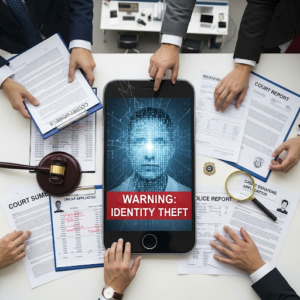The Silent Scourge:
Why Identity Theft Is No Joke
“Identity theft is not a joke, Jim!
Millions of families suffer every year!” –
Dwight Schrute
Dwight Schrute’s words, spoken over a decade and a half ago, are more relevant than ever. In our hyper-connected world, a single click on a fake “bank update” link, using the same password for multiple accounts, or sharing an Aadhaar scan over email can land you squarely on an identity thief’s radar.
Identity theft is the act of a criminal obtaining and using another person’s private data, such as their name, Social Security number, or credit card details, without permission, typically for financial gain. As the digital landscape expands, so do the methods of attack—from hacking and phishing to credit card skimming. A 2025 study on identity theft ranked India first among researched countries, with an estimated 27.2 million adult and fraud victims.
While India has legal protections like Section 66C of the Information Technology Act, 2000, and government portals such as cybercrime.gov.in, the threat remains strong. The core problem is the very nature of the crime itself: it hides in the shadows of the cyber world, leaving little to no evidence.
True Tales of Stolen Identities
The human cost of this invisible crime is staggering, as seen in these real-life cases:
-
- The Disappearance of Tarun Jinaraj: Tarun, a man who allegedly murdered his wife, Sajni, in Ahmedabad, vanished for 15 years. He stole his friend’s identity, forged documents, and built a new life in Bengaluru, even getting remarried. His cover was finally blown by a single phone call to his mother, proving that while a stolen identity can delay justice, it can’t erase the past.
- The Many Faces of Tanmay Goswamy: For a decade, Tanmay Goswamy operated under multiple fake identities on matrimonial sites. Posing as a tax officer or a wealthy consultant, he wooed successful women and convinced them to send him money for fabricated family crises. By the time he was caught, he had cheated at least eight women out of more than ₹1.25 crore, a stark reminder that a false identity can hide behind a smiling profile.
- Voices from Jamtara: The small district of Jamtara became so notorious for cybercrime that it inspired a hit TV series. Brothers Pradip and Pradyuman Mondal would pretend to be bank employees, siphoning off money by getting victims to share their details and OTPs. Their story highlights how easily an industry of identity theft can flourish, fueled by fake KYC documents and easy access to SIM cards.
The Challenges of Tracing Identity Theft Crimes
Even with advanced technology, tracking down perpetrators is like chasing a shadow.
-
- Anonymous Execution: Thieves use VPNs and the TOR network to disguise their IP addresses, making it nearly impossible for investigators to pinpoint their location.
- Cross-Border Operations: A fraudster in one country can steal data from someone on the other side of the globe, creating jurisdictional nightmares and making collaboration between law enforcement agencies slow and difficult.
- Legal Limitations: India’s laws lack specificity for modern, sophisticated cybercrimes, and the absence of a comprehensive “Identity Theft Act” creates loopholes that criminals exploit.
- Investigative Hurdles: Many police forces lack the specialized cyber-forensic resources and trained personnel needed to track these crimes, particularly in smaller towns and rural areas.
Prevention is Better Than Cure
In the fight against identity theft, prevention is not just better it’s often the only realistic defense.
-
- For Individuals: Be vigilant. Use unique and strong passwords, enable two-factor authentication, and never share sensitive details like OTPs. Regularly monitor your bank statements and credit reports for any suspicious activity.
- For Organizations: Invest in robust cybersecurity, train employees to recognize and avoid phishing scams, and conduct regular security audits to fix vulnerabilities.
Ultimately, protecting your identity is a collective effort. The more discerning and aware we are, the less room there is for criminals to operate. It’s not just about keeping cash safe; it’s about safeguarding your trust, your reputation, and your sense of security.
References [1] https://cybercrime.gov.in/Accept.aspx
Contributed by : Ms. Ishika Preetam / Mr. Naren Raja
Astrea Legal Associates LLP
www.astrealegal.com
Note: This publication is provided for general information and does not constitute any legal opinion.This publication is protected by copyright. © 2025,Astrea Legal Associates LLP





